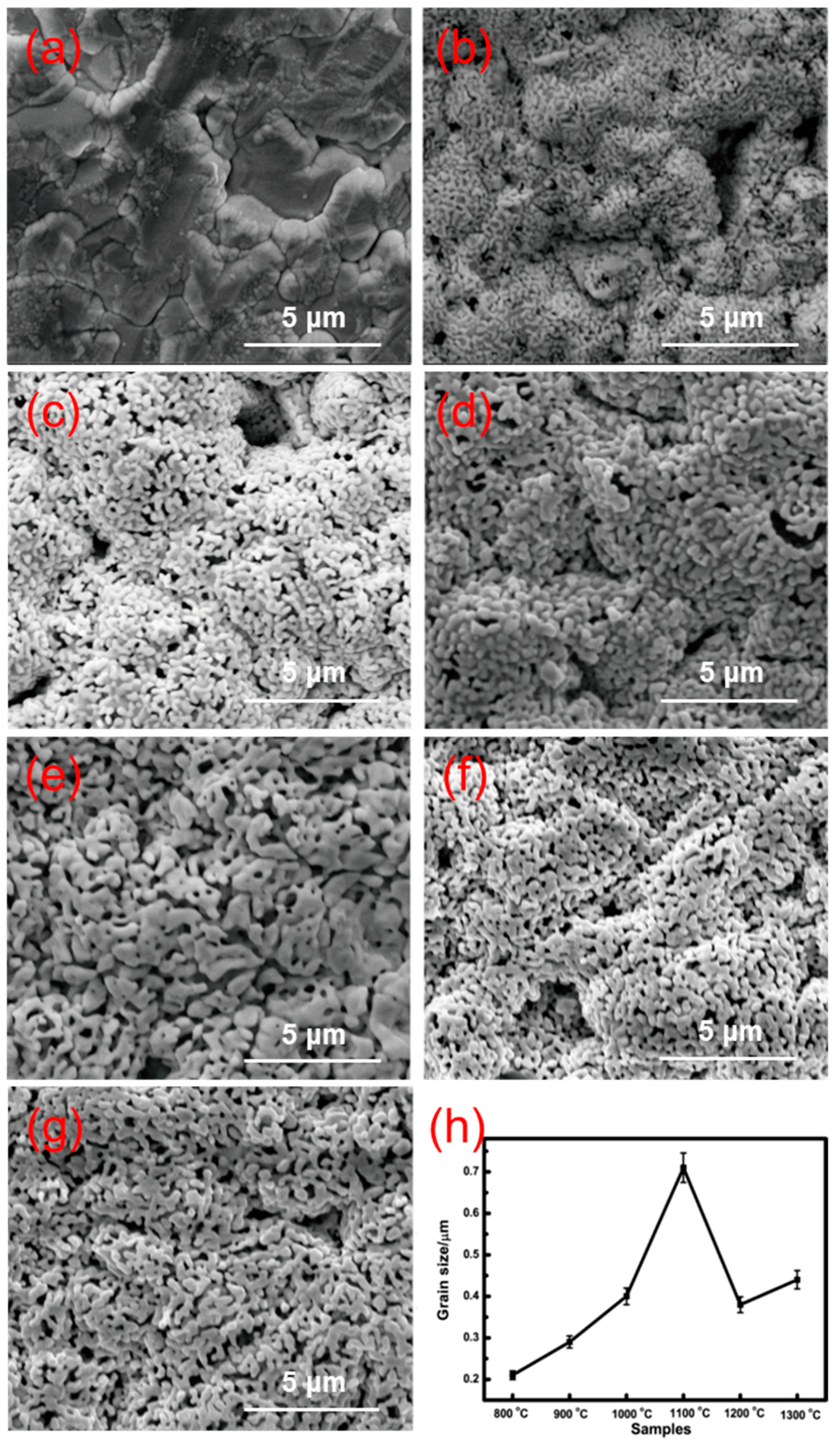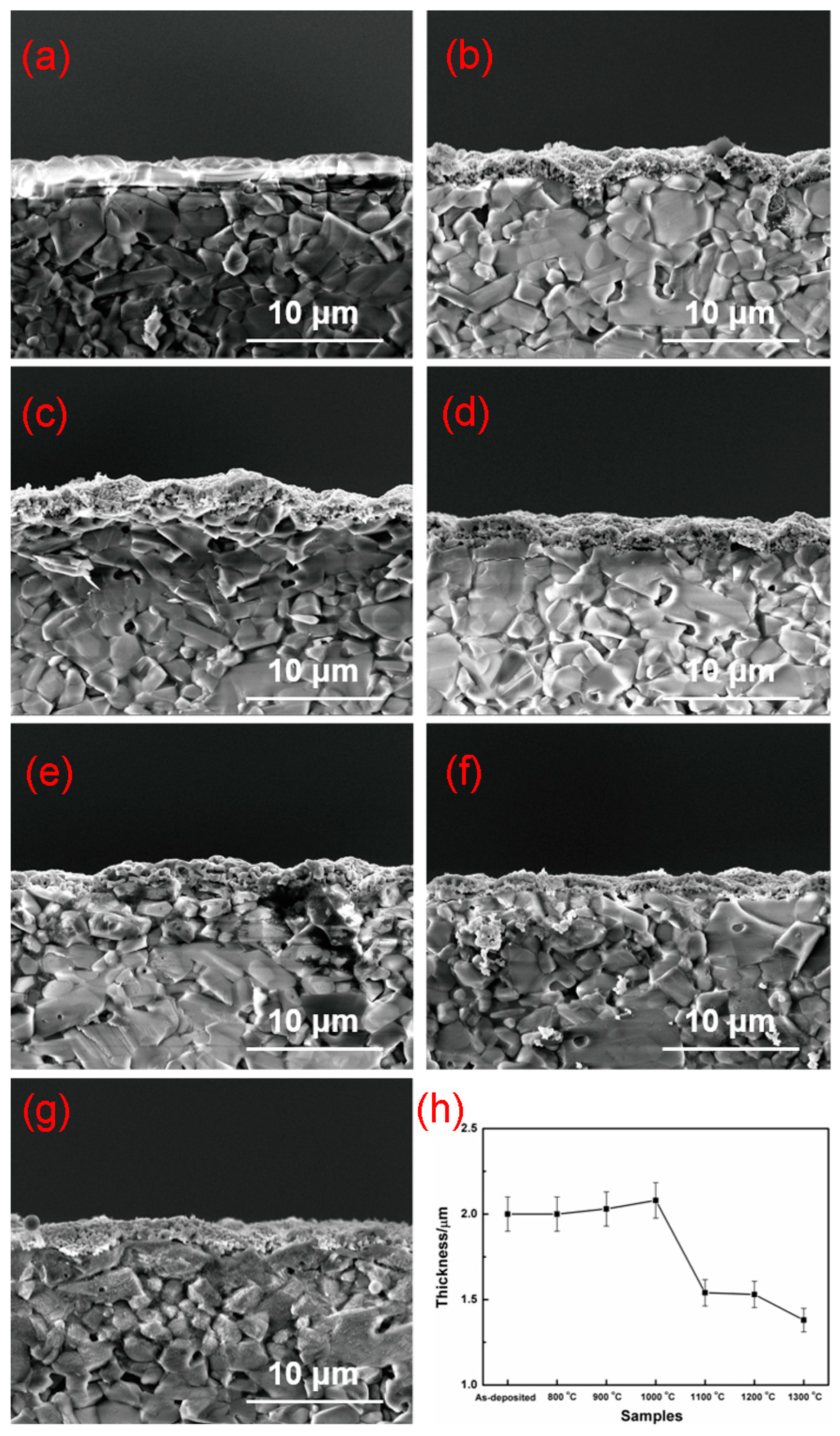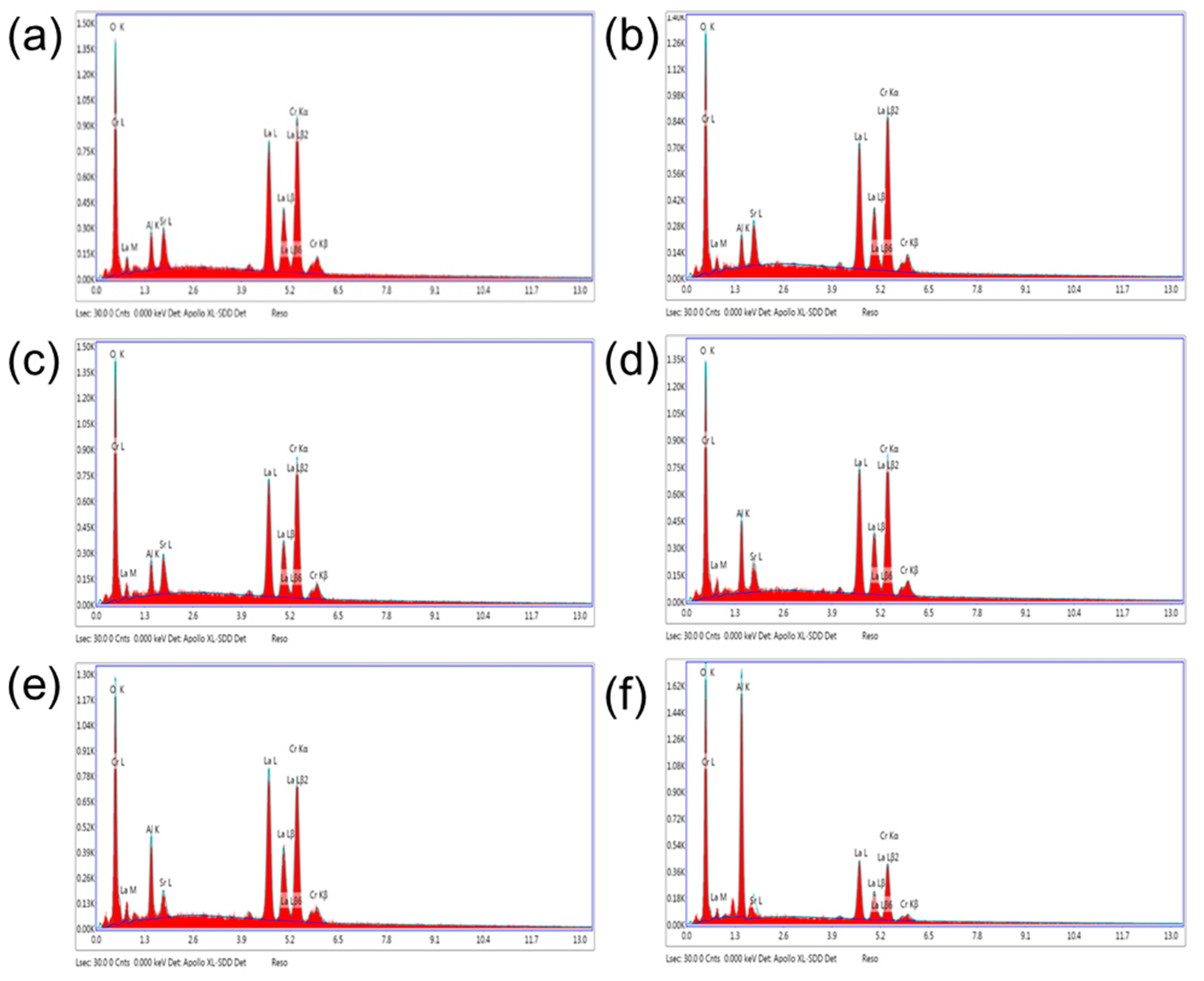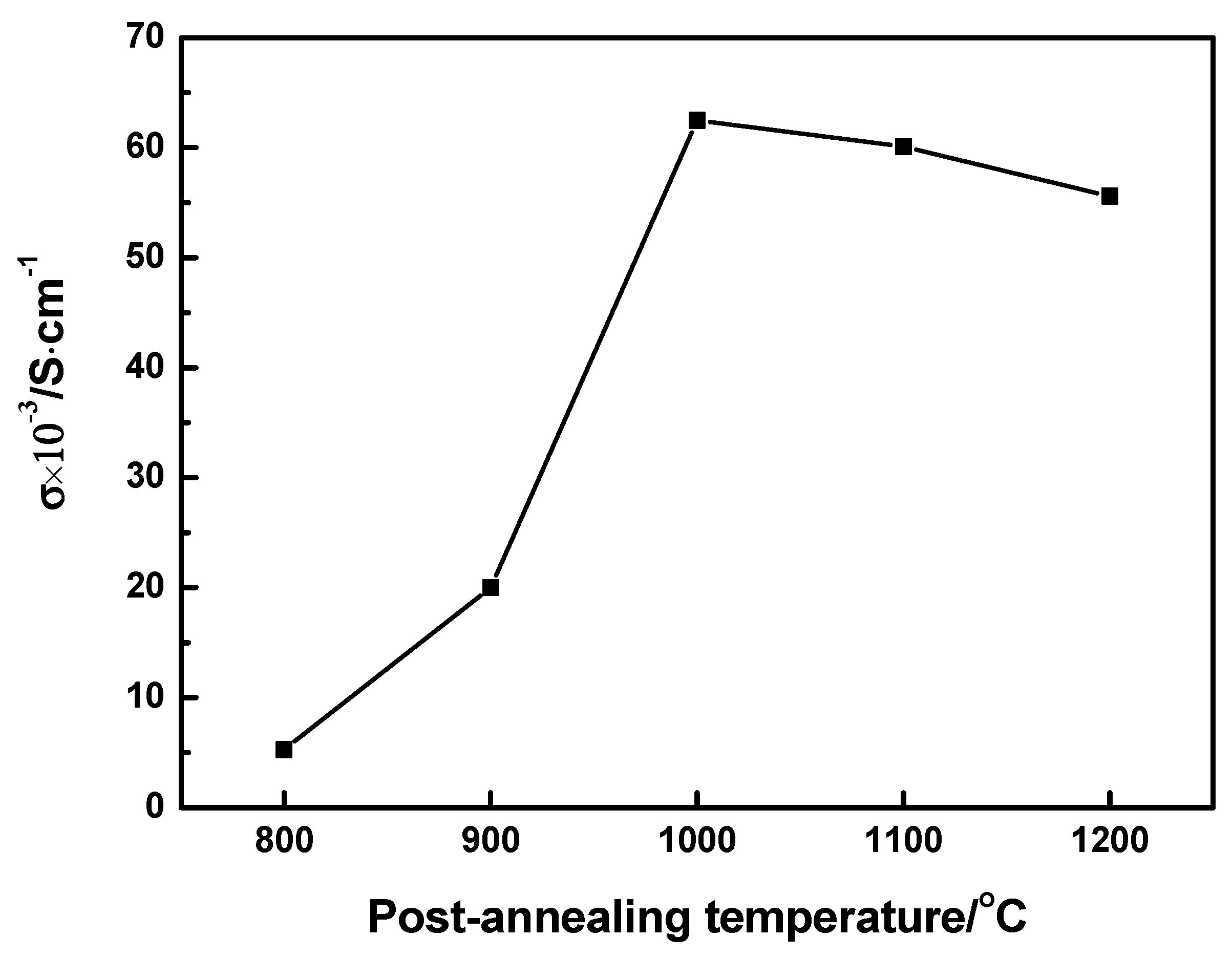Optimizing the Properties of La0.8Sr0.2CrO3 Thin Films through Post-Annealing for High-Temperature Sensing
Abstract
:1. Introduction
2. Experimental Sections
3. Results
4. Discussion
5. Conclusions
Author Contributions
Funding
Acknowledgments
Conflicts of Interest
References
- Zhang, Z.; Tian, B.; Yu, Q.; Shi, P.; Lin, Q.; Zhao, N.; Jing, W.; Jiang, Z. Range Analysis of Thermal Stress and Optimal Design for Tungsten-Rhenium Thin Film Thermocouples Based on Ceramic Substrates. Sensors 2017, 17, 857. [Google Scholar] [CrossRef] [PubMed]
- Zhao, N.; Lin, Q.; Jing, W.; Jiang, Z.; Wu, Z.; Yao, K.; Tian, B.; Zhang, Z.; Shi, P. High temperature high sensitivity Mach-Zehnder interferometer based on waist-enlarged fiber bitapers. Sens. Actuators A Phys. 2017, 267, 491–495. [Google Scholar] [CrossRef]
- Srinivasan, K.; Sundararajan, T.; Narayanan, S.; Jothi, T.J.S.; Rohit Sarma, C.S.L.V. Acoustic pyrometry in flames. Measurement 2013, 46, 315–323. [Google Scholar] [CrossRef]
- Tian, B.; Zhang, Z.; Shi, P.; Zheng, C.; Yu, Q.; Jing, W.; Jiang, Z. Tungsten-rhenium thin film thermocouples for SiC-based ceramic matrix composites. Rev. Sci. Instrum. 2017, 88, 015007. [Google Scholar] [CrossRef] [PubMed]
- Choi, H.; Li, X. Fabrication and application of micro thin film thermocouples for transient temperature measurement in nanosecond pulsed laser micromachining of nickel. Sens. Actuators A Phys. 2007, 136, 118–124. [Google Scholar] [CrossRef]
- Kreider, K.G.; Gillen, G. High temperature materials for thin-film thermocouples on silicon wafers. Thin Solid Films 2000, 376, 32–37. [Google Scholar] [CrossRef]
- Liu, S.; Duan, F.L.; Ji, Z.; Xie, Z.; Hong, Z.; Wang, C.; Xie, X. Accurate and Precise Surface Temperature Measurements Up to 1500 °C Using Thin Film Thermocouple Sensors. In Proceedings of the AIAA Scitech 2021 Forum, Virtual Event, 11–15 & 19–21 January 2021. [Google Scholar]
- Tian, B.; Liu, Y.; Zhang, Z.; Liu, Z.; Zhao, L.; Lin, Q.; Shi, P.; Mao, Q.; Lu, D.; Jiang, Z. Effect of Annealing on the Thermoelectricity Properties of the WRe26-In2O3 Thin Film Thermocouples. Micromachines 2020, 11, 664. [Google Scholar] [CrossRef]
- Benedict, R.P.; Hoersch, H. Manual on the Use of Thermocouples in Temperature Measurement; ASTM: West Conshohocken, PA, USA, 1993. [Google Scholar]
- Burgess, D.; Yust, M.; Kreider, K. Transient thermal response of plasma-sprayed zirconia measured with thin-film thermocouples. Sens. Actuators A Phys. 1990, 24, 155–161. [Google Scholar] [CrossRef]
- Bhatt, H.D.; Vedula, R.; Desu, S.B.; Fralick, G.C. Thin film TiC/TaC thermocouples. Thin Solid Films 1999, 342, 214–220. [Google Scholar] [CrossRef]
- Samsonov, G.V.; Kislyĭ, P.S. High Temperature Nonmetallic Thermocouples and Sheaths; Consultants Bureau: Southern California, CA, USA, 1967. [Google Scholar]
- Von Moll, A.; Behbahani, A.R.; Fralick, G.C.; Wrbanek, J.D.; Hunter, G.W. A Review of Exhaust Gas Temperature Sensing Techniques for Modern Turbine Engine Controls. In Proceedings of the 50th AIAA/ASME/SAE/ASEE Joint Propulsion Conference, Cleveland, OH, USA, 28–30 July 2014. [Google Scholar]
- Chen, X.; Gregory, O.J.; Amani, M. Thin-Film Thermocouples Based on the System In2O3-SnO2. J. Am. Ceram. Soc. 2010, 94, 854–860. [Google Scholar] [CrossRef]
- Kreider, K.G. Thin-film transparent thermocouples. Sens. Actuators A Phys. 1992, 34, 95–99. [Google Scholar] [CrossRef]
- Kreider, K.G. High temperature silicide thin-film thermocouples. Mater. Res. Soc. Symp. Proc. 1993, 322, 285–290. [Google Scholar] [CrossRef]
- Liu, D.; Shi, P.; Ren, W.; Liu, Y.; Liu, M.; Niu, G.; Lin, Q.; Tian, B.; Jiang, Z.; Ye, Z.-G. Facile high-performance film thermocouple made of strontium lanthanum chromate for temperature sensing in air. J. Am. Ceram. Soc. 2018, 101, 4880–4886. [Google Scholar] [CrossRef]
- Liu, D.; Shi, P.; Ren, W.; Liu, Y.; Liu, M.; Zhang, Y.; Lin, Q.; Tian, B.; Jiang, Z.; Ye, Z.-G. Investigation on thermoelectric properties of screen-printed La1−xSrxCrO3-In2O3 thermocouples for high temperature sensing. J. Eur. Ceram. Soc. 2018, 38, 5030–5035. [Google Scholar] [CrossRef]
- Liu, D.; Shi, P.; Ren, W.; Liu, Y.; Liu, M.; Zhang, Y.; Tian, B.; Lin, Q.; Jiang, Z.; Ye, Z.-G. Fabrication and characterization of La0.8Sr0.2CrO3/In2O3 thin film thermocouple for high temperature sensing. Sens. Actuators A Phys. 2018, 280, 459–465. [Google Scholar] [CrossRef]
- Liu, Y.; Ren, W.; Shi, P.; Liu, D.; Liu, M.; Jing, W.; Tian, B.; Ye, Z.-G.; Jiang, Z. Preparation and thermal volatility characteristics of In2O3/ITO thin film thermocouple by RF magnetron sputtering. AIP Adv. 2017, 7, 115025. [Google Scholar] [CrossRef] [Green Version]
- Liu, Y.; Ren, W.; Shi, P.; Liu, D.; Zhang, Y.; Liu, M.; Lin, Q.; Tian, B.; Jiang, Z. Microstructure and thermoelectric properties of In2O3/ITO thin film thermocouples with Al2O3 protecting layer. J. Mater. Sci. Mater. Electron. 2018, 30, 1786–1793. [Google Scholar] [CrossRef]
- Liu, Y.; Ren, W.; Shi, P.; Liu, D.; Zhang, Y.; Liu, M.; Ye, Z.-G.; Jing, W.; Tian, B.; Jiang, Z. A Highly Thermostable In2O3/ITO Thin Film Thermocouple Prepared via Screen Printing for High Temperature Measurements. Sensors 2018, 18, 958. [Google Scholar] [CrossRef] [Green Version]
- Zhu, W.; Deevi, S. Development of interconnect materials for solid oxide fuel cells. Mater. Sci. Eng. A 2003, 348, 227–243. [Google Scholar] [CrossRef]
- Karim, D.P.; Aldred, A.T. Localized level hopping transport in La(Sr)CrO3. Phys. Rev. B 1979, 20, 2255–2263. [Google Scholar] [CrossRef]
- Brylewski, T.; Dabek, J.; Przybylski, K.; Morgiel, J.; Rekas, M. Screen-printed (La,Sr)CrO3 coatings on ferritic stainless steel interconnects for solid oxide fuel cells using nanopowders prepared by means of ultrasonic spray pyrolysis. J. Power Sources 2012, 208, 86–95. [Google Scholar] [CrossRef]
- Pintossi, D.; Iannaccone, G.; Colombo, A.; Bella, F.; Välimäki, M.; Väisänen, K.L.; Hast, J.; Levi, M.; Gerbaldi, C.; Dragonetti, C.; et al. Luminescent Downshifting by Photo-Induced Sol-Gel Hybrid Coatings: Accessing Multifunctionality on Flexible Organic Photovoltaics via Ambient Temperature Material Processing. Adv. Electron. Mater. 2016, 2, 1600288. [Google Scholar] [CrossRef]
- Seo, S.; Ryu, J.; Kim, S.; Jeong, J.; Jin, S. Enhancement of Photodetective Properties on Multilayered MoS2 Thin Film Transistors via Self-Assembled Poly-L-Lysine Treatment and Their Potential Application in Optical Sensors. Nanomaterials 2021, 11, 1586. [Google Scholar] [CrossRef]
- Bella, F.; De Luca, S.; Fagiolari, L.; Versaci, D.; Amici, J.; Francia, C.; Bodoardo, S. An Overview on Anodes for Magnesium Batteries: Challenges towards a Promising Storage Solution for Renewables. Nanomaterials 2021, 11, 810. [Google Scholar] [CrossRef] [PubMed]
- Pugliese, D.; Lamberti, A.; Bella, F.; Sacco, A.; Bianco, S.; Tresso, E. TiO2 nanotubes as flexible photoanode for back-illuminated dye-sensitized solar cells with hemi-squaraine organic dye and iodine-free transparent electrolyte. Org. Electron. 2014, 15, 3715–3722. [Google Scholar] [CrossRef]
- Sacco, A.; Bella, F.; Pierre, S.D.; Castellino, M.; Bianco, S.; Bongiovanni, R.; Pirri, C.F. Electrodes/Electrolyte Interfaces in the Presence of a Surface-Modified Photopolymer Electrolyte: Application in Dye-Sensitized Solar Cells. Chem. Phys. Chem. 2015, 16, 960–969. [Google Scholar] [CrossRef]
- Campbell, I.A.; Turnbull, G.A. A kinetic model of thin-film fluorescent sensors for strategies to enhance chemical selectivity. Phys. Chem. Chem. Phys. 2021, 23, 10791–10798. [Google Scholar] [CrossRef] [PubMed]
- Liang, Q.; Liu, H.; Wang, C.; Li, B. Phenotypic Characterization Analysis of Human Hepatocarcinoma by Urine Metabolomics Approach. Sci. Rep. 2016, 6, 19763. [Google Scholar] [CrossRef] [Green Version]
- Liu, D.; Shi, P.; Ren, W.; Liu, Y.; Liu, M.; Zhang, Y.; Tian, B.; Lin, Q.; Jiang, Z.; Ye, Z.-G. Enhanced La0.8Sr0.2CrO3/Pt thin film thermocouple with Al2O3 coating layer for high temperature sensing. Ceram. Int. 2018, 44, S233–S237. [Google Scholar] [CrossRef]
- Mori, M.; Yamamoto, T.; Ichikawa, T.; Takeda, Y. Dense sintered conditions and sintering mechanisms for alkaline earth metal (Mg, Ca and Sr)-doped LaCrO3 perovskites under reducing atmosphere. Solid State Ion. 2002, 148, 93–101. [Google Scholar] [CrossRef]
- Johnson, C.; Gemmen, R.; Orlovskaya, N. Nano-structured self-assembled LaCrO3 thin film deposited by RF-magnetron sputtering on a stainless steel interconnect material. Compos. Part B Eng. 2004, 35, 167–172. [Google Scholar] [CrossRef]
- ASTM E230/E230M-12. Standard Specification and Temperature Electromotive Force (emf) Tables for Standardized Thermocouples; ASTM International: West Conshohocken, PA, USA, 2012. [Google Scholar]






| Temperature (°C) | Element Atomic Ratio (%) | ||||
|---|---|---|---|---|---|
| O | Al | Sr | La | Cr | |
| 800 | 55.23 | 6.12 | 2.76 | 15.4 | 20.48 |
| 900 | 57.46 | 5.14 | 2.96 | 12.96 | 21.48 |
| 1000 | 59.58 | 5.94 | 2.7 | 12.57 | 19.22 |
| 1100 | 55.24 | 11.53 | 2.22 | 13.06 | 17.96 |
| 1200 | 54.56 | 12.07 | 1.73 | 14.46 | 17.17 |
| 1300 | 61.26 | 25.12 | 1.42 | 5.53 | 6.67 |
| Post-Annealing Temperature (°C) | Seebeck Coefficient (µV/°C) |
|---|---|
| 900 | 59.0 |
| 1000 | 62.2 |
| 1100 | 167.8 |
| 1200 | 114.1 |
Publisher’s Note: MDPI stays neutral with regard to jurisdictional claims in published maps and institutional affiliations. |
© 2021 by the authors. Licensee MDPI, Basel, Switzerland. This article is an open access article distributed under the terms and conditions of the Creative Commons Attribution (CC BY) license (https://creativecommons.org/licenses/by/4.0/).
Share and Cite
Liu, D.; Shi, P.; Liu, Y.; Zhang, Y.; Tian, B.; Ren, W. Optimizing the Properties of La0.8Sr0.2CrO3 Thin Films through Post-Annealing for High-Temperature Sensing. Nanomaterials 2021, 11, 1802. https://doi.org/10.3390/nano11071802
Liu D, Shi P, Liu Y, Zhang Y, Tian B, Ren W. Optimizing the Properties of La0.8Sr0.2CrO3 Thin Films through Post-Annealing for High-Temperature Sensing. Nanomaterials. 2021; 11(7):1802. https://doi.org/10.3390/nano11071802
Chicago/Turabian StyleLiu, Dan, Peng Shi, Yantao Liu, Yijun Zhang, Bian Tian, and Wei Ren. 2021. "Optimizing the Properties of La0.8Sr0.2CrO3 Thin Films through Post-Annealing for High-Temperature Sensing" Nanomaterials 11, no. 7: 1802. https://doi.org/10.3390/nano11071802
APA StyleLiu, D., Shi, P., Liu, Y., Zhang, Y., Tian, B., & Ren, W. (2021). Optimizing the Properties of La0.8Sr0.2CrO3 Thin Films through Post-Annealing for High-Temperature Sensing. Nanomaterials, 11(7), 1802. https://doi.org/10.3390/nano11071802








